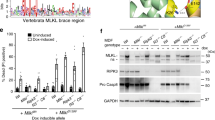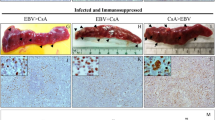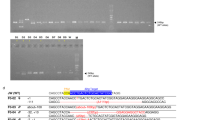Abstract
DISEASES which develop in gnotobiotic (germfree; mice reflect defects in the nutritional, genetic or microbial status of the host. Three viral agents have been detected so far in germfree mice, and these appear to be passed to their progeny by congenital route(s). All mouse strains carry leukaemia virus1, some strains carry mammary tumour virus2 and one strain carries lymphocytic choriomeningitis (LCM) virus3. Except for these, germfree mice are free of bacteria, fungi and parasites. They are referred to here as germfree, on the understanding that they are not free of virus. Spontaneous lymphatic leukaemia develops only in the AKR strain: in other strains (Balb/c, ICR, CFW, C3H, Swiss–Webster and C57 BL) lymphatic leukaemia must be elicited by whole body exposure to X-rays4,5. Germfree mice of the AKR strain develop the same type and incidence of spontaneous lymphatic leukaemia as the conventional stock from which they were derived. In addition, an unusual syndrome which has been referred to as “puny” disease6 has been observed in germfree AKR mice; the mice are hunched and have rough hair and dermatitis with depilation around the anus and base of the tail. Diarrhoea was difficult to assess because the faeces of germfree mice are usually semisolid in consistency. “Puny” disease has been observed in twenty-eight germfree AKR mice of average age 14 weeks. At autopsy the mice had large lymph nodes and spleens and small, almost imperceptible, thymus glands. The lymph nodes were swollen with extensive perivascular cords of lymphocytes and plasma-like cells in the medullary areas, but the prominent cortical follicles were free of germinal zones. Germinal zones were not observed in the white pulps of the spleens, but the red pulps were congested with lymphoid and plasma-like cells. The thymic cortices were depleted of thymocytes; however, in several of them, segments of the cortex contained aggregations of large reticulum cells, many in mitosis. The latter changes were suggestive of early stage thymic lymphoma, which may have been coincident with, or a sequel to, the thymic depletion.
This is a preview of subscription content, access via your institution
Access options
Subscribe to this journal
Receive 51 print issues and online access
$199.00 per year
only $3.90 per issue
Buy this article
- Purchase on Springer Link
- Instant access to full article PDF
Prices may be subject to local taxes which are calculated during checkout
Similar content being viewed by others
References
Pollard, M., and Matsuzawa, T., Proc. Soc. Exp. Biol. and Med., 116, 967 (1964).
Kajima, M., and Pollard, M., J. Bacteriol., 90, 1448 (1965).
Pollard, M., Sharon, N., and Teah, B. A., Proc. Soc. Exp. Biol. and Med., 127, 755 (1968).
Pollard, M., Kajima, M., and Teah, B. A., Proc. Soc. Exp. Biol. and Med., 120, 72 (1965).
Pollard, M., Nat. Cancer Inst. Monog., No. 20, 167 (1965).
Pollard, M., Nature, 213, 142 (1967).
Condgon, C. C., and Urso, I. S., Amer. J. Pathol., 33, 749 (1957).
De Vries, M. J., and Vos, O., J. Nat. Cancer Inst., 23, 1403 (1959).
Wilson, R., and Connell, M. S., J. Exp. Hematol., 7, 56 (1964).
van Bekkum, D. W., De Vries, M. J., and van der Waay, D., J. Nat. Cancer Inst., 38, 223 (1967).
Loutit, Y. F., and Micklem, H. S., Brit. J. Exp. Pathol., 43, 77 (1962).
van Bekkum, D. W., and Vos, O., Intern. J. Radiat. Biol., 3, 173 (1961).
East, J., Parrott, D. M. V., Chesterman, F. C., and Pomerance, A., J. Exp. Med., 118, 1069 (1963).
Dameshek, W., Israeli J. Med. Sci., 1, 1304 (1965).
East, J., and Prosser, P. R., Proc. Roy. Soc. Med., 60, 823 (1967).
Schwartz, R., Andre-Schwartz, J., Armstrong, M. Y. K., and Beldotti, L., Ann. NY Acad. Sci., 129, 804 (1968).
Arneson, K., Acta Pathol. Microbiol. Scand., 43, 350 (1958).
Siegler, R., and Rich, M. A., Cancer Res., 23, 1669 (1963).
Pollard, M., Kajima, M., and Sharon, N., Perspectives in Virology, VI (edit. by Pollard, M.), 193 (Academic Press, NY, 1968).
Author information
Authors and Affiliations
Rights and permissions
About this article
Cite this article
POLLARD, M. Spontaneous “Secondary” Disease in Germfree AKR Mice. Nature 222, 92–94 (1969). https://doi.org/10.1038/222092b0
Received:
Issue Date:
DOI: https://doi.org/10.1038/222092b0
This article is cited by
-
Multinucleated acinar cells in the pancreases of AKR and C58 mice
Experientia (1973)
Comments
By submitting a comment you agree to abide by our Terms and Community Guidelines. If you find something abusive or that does not comply with our terms or guidelines please flag it as inappropriate.



